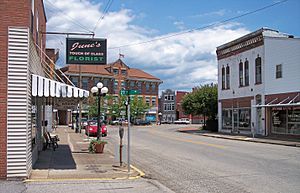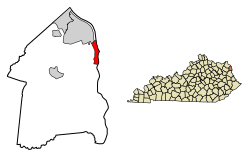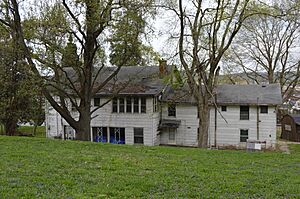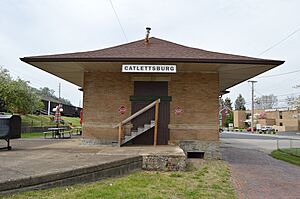Catlettsburg, Kentucky facts for kids
Quick facts for kids
Catlettsburg, Kentucky
|
|
|---|---|

Louisa Street in downtown Catlettsburg in 2007
|
|

Location of Catlettsburg in Boyd County, Kentucky.
|
|
| Country | |
| State | |
| County | Boyd |
| Area | |
| • Total | 1.73 sq mi (4.49 km2) |
| • Land | 1.33 sq mi (3.46 km2) |
| • Water | 0.40 sq mi (1.04 km2) |
| Elevation | 554 ft (169 m) |
| Population
(2020)
|
|
| • Total | 1,780 |
| • Estimate
(2022)
|
1,746 |
| • Density | 1,334.33/sq mi (515.17/km2) |
| Time zone | UTC-5 (EST) |
| • Summer (DST) | UTC-4 (EDT) |
| ZIP code |
41129
|
| Area code(s) | 606 |
| FIPS code | 21-13420 |
| GNIS feature ID | 0489094 |
Catlettsburg is a city in Boyd County, Kentucky, United States. It is also the main city, or 'county seat,' of Boyd County. In 2020, about 1,780 people lived there. Catlettsburg is part of a larger area called the Huntington–Ashland metropolitan area.
Contents
History
Early Days of Catlettsburg
Catlettsburg's story started soon after the American Revolution. Many pioneers traveled through this area on their way west, following the Ohio River. Alexander Catlett was the first landowner here, arriving in 1798.
His son, Horatio Catlett, opened a post office in 1810. This was when the name 'Catlettsburg' was first officially used. Before that, the area was known as "Mouth of Sandy."
In 1849, James Wilson Fry, who bought the land from the Catlett family, started selling lots for the new town. The Catlett family had run a business here since about 1811. It was a tavern, post office, trading post, and inn, all in a log building.
Because of its location on the frontier, the Catletts welcomed famous guests. These included General Stonewall Jackson, Henry Clay, and future U.S. President James Garfield. Their business grew as more river traffic passed through, and the town of Catlettsburg developed around it.
Railroads and Important Buildings
Collis P. Huntington's Chesapeake and Ohio Railway built a line to Cincinnati in 1888. This required building a railroad bridge over the Big Sandy River at Catlettsburg. Today, about 80 trains cross this bridge daily.
The Catlett House from 1812 is still standing. It was later used as the "servants' quarters" for a large home called Beechmoor Place. In 1868, Col. Laban T. Moore bought the estate. He was a former member of the U.S. House of Representatives.
Col. Moore named his home Beechmoor. The eastern part of Beechmoor is 200 years old and was built by the Catletts. It is one of the oldest known buildings in the region. It was built with strong, thick walls made of hemlock maple wood.
The Catlett name is still used for Catlett's Creek, a small river that flows into the Ohio River. In the late 1800s, Catlettsburg grew by adding two nearby communities: Hampton City and Sandy City. Around 1890, the city's name changed from 'Catlett's Burg' to 'Catlettsburg'.
Catlettsburg During the Civil War
During the American Civil War, Catlettsburg was a supply base for the Union Army. The First Presbyterian Church, built in 1875, was used as an army hospital. This church building is still used today. It is one of only two truly Gothic buildings still standing in the U.S.
Timber and Transportation
From the late 1800s to the early 1920s, Catlettsburg was the biggest market for hardwood timber in the world. This was because of its location at the mouth of the Big Sandy River. Most of the old-growth timber in the area was cut down during this time.
Railroads slowly became more important than river travel. The Chesapeake & Ohio (C&O) railroad built a bridge connecting Catlettsburg with Kenova, West Virginia in 1885. This bridge is still used by CSX Transportation trains many times a day. It is also used by Amtrak's Cardinal passenger train, which travels from Chicago to New York City.
The Chesapeake & Ohio Railway built a passenger station in Catlettsburg in 1906. It was used for over 50 years until 1958, when passenger service moved to nearby Ashland. The city bought the station for $1 and has used it as a community center. In 2006, Russell Compton helped pay to restore the station to its original look. It was renamed the Russell Compton Community Center in his honor in 2007.
Geography
Catlettsburg is located at 38°24′59″N 82°36′10″W / 38.41639°N 82.60278°W.
The United States Census Bureau says the city covers about 1.6 square miles (4.1 square kilometers). Of this, about 1.3 square miles (3.4 square kilometers) is land, and 0.4 square miles (1.0 square kilometer) is water.
Population Information
| Historical population | |||
|---|---|---|---|
| Census | Pop. | %± | |
| 1870 | 1,019 | — | |
| 1880 | 1,225 | 20.2% | |
| 1890 | 1,374 | 12.2% | |
| 1900 | 3,081 | 124.2% | |
| 1910 | 3,520 | 14.2% | |
| 1920 | 4,183 | 18.8% | |
| 1930 | 5,025 | 20.1% | |
| 1940 | 4,524 | −10.0% | |
| 1950 | 4,750 | 5.0% | |
| 1960 | 3,874 | −18.4% | |
| 1970 | 3,420 | −11.7% | |
| 1980 | 3,005 | −12.1% | |
| 1990 | 2,231 | −25.8% | |
| 2000 | 1,960 | −12.1% | |
| 2010 | 1,856 | −5.3% | |
| 2020 | 1,780 | −4.1% | |
| 2022 (est.) | 1,746 | −5.9% | |
| U.S. Decennial Census | |||
In 2000, there were 1,960 people living in Catlettsburg. Most residents were White (98.16%). A small number were African American (1.12%) or Native American (0.20%).
About 23.9% of households had children under 18. The average household had 2.25 people. The average family had 2.85 people.
The population was spread out by age:
- 20.4% were under 18
- 10.4% were 18 to 24
- 28.1% were 25 to 44
- 24.2% were 45 to 64
- 16.9% were 65 or older
The average age was 38 years.
The median income for a household was $24,167. For a family, it was $34,118. About 21.6% of the population lived below the poverty line. This included 28.3% of those under 18.
Education
The Catlettsburg Independent School District joined the Boyd County School District in 1974. Before that, Catlettsburg had three elementary schools and one high school.
After the merger, Catlettsburg High School became Catlettsburg Junior High. Yost Elementary and Haney Elementary closed. Students then went to Hatfield Elementary, which was later renamed Catlettsburg Elementary.
Yost Elementary School, built in 1894, was one of the oldest operating school buildings in Kentucky when it closed in 1980.
Today, Catlettsburg Elementary is the only school in the city. It uses the campus of the former high school/junior high. The school's gymnasium was built in 1935 by the Works Progress Administration. This gym hosts many community events.
Catlettsburg also has a public library. It is a branch of the Boyd County Public Library.
Notable People
- Mary Elliott Flanery, the first woman elected to the state legislature in Kentucky (1921–23).
- Nannie Scott Honshell, an important ironmaster, was born here.
- Billy C. Clark, a well-known author. His novel Goodbye Kate was bought by The Walt Disney Company.
- George B. Martin, a U.S. Senator (1918–19), grew up and died in Catlettsburg.
- Michael Polakovs, a clown who helped redesign the Ronald McDonald character, lived in this area.
- Ben Williamson, a U.S. Senator from Catlettsburg.
- Laban T. Moore, a member of the U.S. House of Representatives.
- Ed Haley, a famous blind fiddler, lived in Catlettsburg in the 1930s.
Images for kids
See also
 In Spanish: Catlettsburg (Kentucky) para niños
In Spanish: Catlettsburg (Kentucky) para niños






